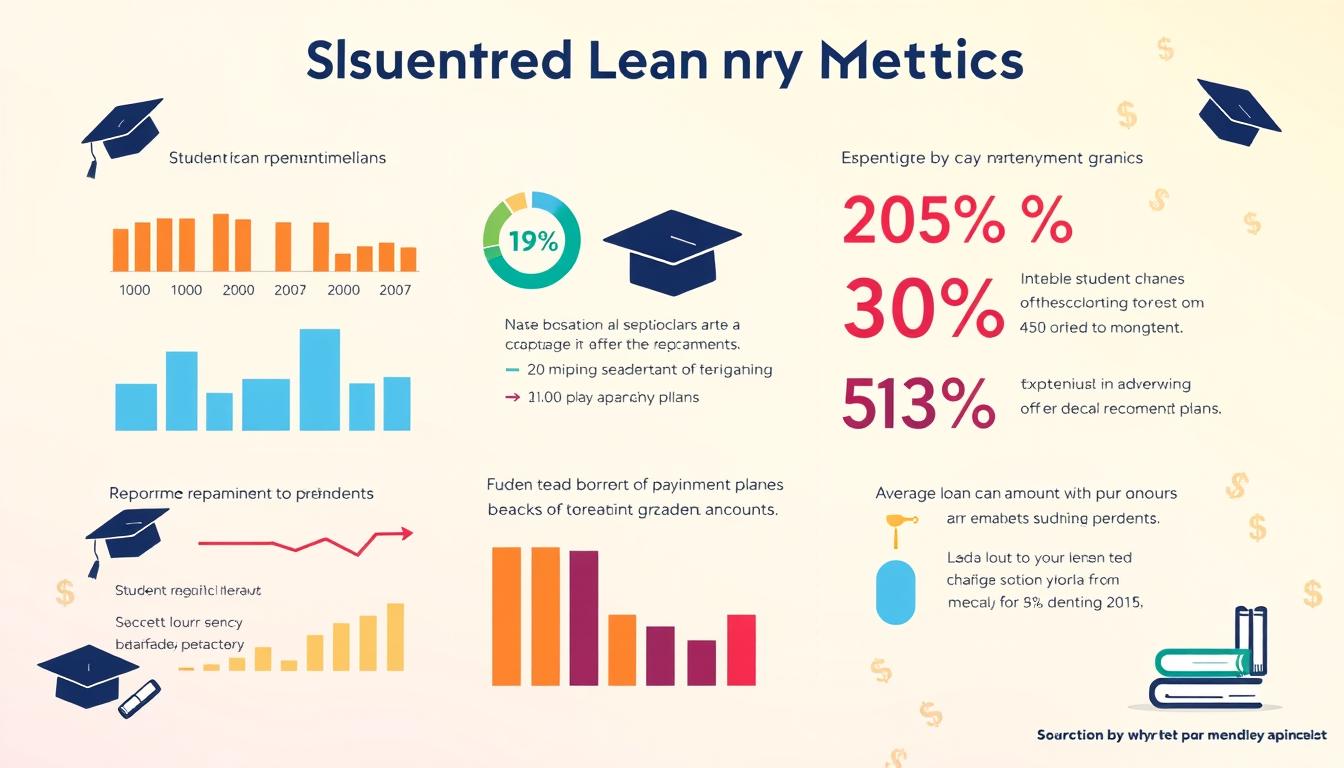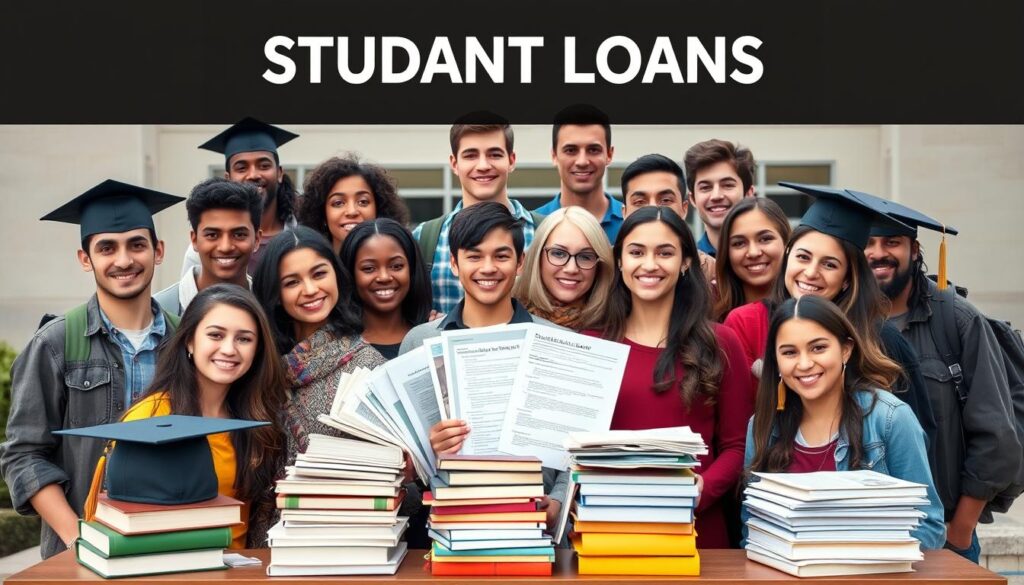student loan repayment metrics

The student loan debt crisis in the United States is a big issue. It’s important to understand the key metrics of loan repayment. With $1.753 trillion in student loan debt, mostly federal, we need to look at the trends and patterns.
The average federal student loan debt is $37,853. Including private loans, the total average balance can be up to $40,681 per borrower. These numbers show how much debt many Americans have from trying to get a higher education. Recent changes, like restarting loan payments in October 2023 and introducing a new repayment plan in August 2023, have also changed how people repay their loans.
This article will dive into the details of student loan repayment metrics. It aims to give a full picture of the current situation and what affects borrowers’ ability to pay back their loans. We’ll look at default rates, repayment patterns, and how demographic and institutional factors play a role. This will help us understand the complex challenges faced by student loan borrowers in the United States.
Table of Contents
Current State of Student Loan Debt in America
The student loan debt crisis in the United States is huge. The total debt is over $1.6 trillion as of the third quarter of 2024. This massive amount shows how much student loan debt affects millions of Americans. It has big effects on their finances and the whole economy.
Total Outstanding Debt Statistics
According to the U.S. Department of Education, 42.2 million borrowers have federal student loans. This totals over $1.6 trillion in debt. Just over a decade ago, the debt was around $1 trillion. This shows how the crisis has grown.
Federal vs Private Loan Distribution
Federal loans make up 91.2% of the total debt. Private student loans account for 7.2%, with a balance of $128.8 billion. This shows federal loans are much more common.
Average Loan Balances Per Borrower
The average student loan debt per borrower is about $38,175.36 as of the third quarter of 2024. This amount can change a lot. It depends on things like education level, field of study, and where you went to school.
Looking at different age groups, we see a lot of debt. Borrowers between 25 and 34 have $485 billion in federal loans. Those between 35 and 49 have $635 billion. This shows how student loans can affect people’s finances for a long time.
Key Student Loan Repayment Metrics and Performance Indicators
Understanding student loan repayment is complex. We need to look at key performance indicators. These metrics show how well the student loan system is doing and if borrowers are paying back their loans.
The loan repayment rate is very important. It shows what percentage of undergraduate borrowers are making payments or in deferment two years after starting. This tells us if students can handle their debt and keep up with payments.
The delinquency rate and forbearance utilization give us a fuller picture. The delinquency rate shows how many loans are overdue but not yet in default. Forbearance utilization tells us how many borrowers are temporarily stopping payments because of financial problems or other reasons.
| Metric | Definition | Importance |
|---|---|---|
| Loan Repayment Rate | Share of undergraduate borrowers that graduated with federal student loans who are making progress or in deferment 2 years after entering repayment. | Measures the success of borrowers in managing their debt and maintaining payments. |
| Delinquency Rate | The percentage of loans that are overdue but not yet in default. | Indicates the level of financial strain on borrowers and the potential for future defaults. |
| Forbearance Utilization | The proportion of borrowers who have temporarily postponed their payments due to financial hardship or other extenuating circumstances. | Highlights the need for flexible repayment options and the challenges faced by borrowers. |
By watching these key indicators, we can understand the student loan world better. This helps policymakers, educators, and the public make better choices. It also helps improve how student loans work for everyone.
Federal Student Loan Repayment Patterns
The way people pay back federal student loans shows interesting trends. In the first six years, about a quarter of loans see their balances cut by 50% or more. Yet, more than half see their balances go up. Borrowers are in repayment for about 45% of the time, with only 38% of payments being over $10 when due.
Loan Default Rates Over Time
The number of loans in default has gone up, from 4% after one year to 16% after six. This shows the big challenge borrowers face in managing their loans over time.
Forbearance and Deferment Statistics
By 2023, 65.8% of federal student loan debt is in forbearance. This means 61.2% of borrowers are in this situation. It shows how important plans like income-driven repayment and deferment are for borrowers in tough times.
| Metric | Statistic |
|---|---|
| Student Loan Default Rate | 5.47% (2021), dropping to below 1% with the Federal New Start Program |
| Average Student Loan Default Rate | 8.15% |
| Annual Student Loan Defaults | 471,000 students (average since 2011) |
| Students Entering Repayment Annually | 4.6 million |
| Federal Student Loan Debt Share | 92.8% |
| 3-Year Default Rate | 10.3% |
| Texas 5-Year Default Rate | 25% |
| For-Profit 3-Year Default Rate | 14.7% |
| Non-Profit 3-Year Default Rate | 6.39% |
| Bachelor’s Degree 30-Year Default Rate | 10% |
| Associate Degree 30-Year Default Rate | 20% |
| Black/African American Default Rate | 21.8% |
| Hispanic/Latino Default Rate | 10.1% |
| White/Caucasian Default Rate | 6.1% |
| Delinquency Rate (90+ Days) | 0.84% |
| Texas No Suspension Default Rate | 89% |
| Texas Increased Balance After 5 Years | 21% |
| Texas Decreased Balance After 5 Years | 45% |
The data shows a complex picture of federal student loan repayment. It highlights the need for more support for borrowers and ways to tackle high loan default rates and forbearance.
Income-Driven Repayment Plan Analysis
The federal government’s income-driven repayment (IDR) plans are key in managing student loan debt. These plans adjust monthly payments based on the borrower’s income. They have changed how we repay loans, helping prevent defaults and lowering interest for some.
Updates like the Revised Pay As You Earn (REPAYE) plan have made IDR plans better for borrowers. The new SAVE plan, starting after August 31, 2023, will offer even more benefits. It will cap payments at 5-10% of discretionary income and provide full interest subsidies.
IDR plans are vital in reducing default risk. By September 2023, over 9.9 million direct loan recipients were in IDR plans. This is more than 32% of all direct loan borrowers. But, the government might get 57% less from IDR plans than from standard plans.
Understanding IDR plans is key for borrowers to succeed in repaying their loans. Income, family size, and loan amounts affect the best plan choice. Borrowers need to pick the IDR plan that fits their financial situation and goals.
The role of income-driven repayment plans in helping borrowers is crucial. They help avoid defaults and offer sustainable repayment options. Policymakers and loan servicers focus on these plans to help borrowers.
“Selecting the right IDR plan is crucial as loan amounts left after the repayment term are forgiven.”
Institutional Differences in Student Loan Repayment Metrics
Student loan repayment outcomes differ a lot based on the school type. Borrowers at public, private, and for-profit schools face unique challenges. These challenges affect how easily they can repay their loans.
Public vs Private Institution Comparisons
Students at public universities borrow an average of $32,362 for a bachelor’s degree. Those at private non-profit schools borrow about $35,087. Yet, the repayment rates show a big difference.
In May 2020, 9% of public university borrowers were late on payments. Only 7% of private non-profit borrowers were in the same situation.
For-Profit vs Non-Profit Outcomes
For-profit schools show a huge gap in repayment rates. By May 2020, 24% of for-profit school borrowers were late. This is more than double the rate for public university borrowers and triple that of private non-profit borrowers.
Program-Specific Repayment Rates
| Institution Type | 3-Year Loan Repayment Rate |
|---|---|
| Public 4-Year | 70% |
| Private Non-Profit 4-Year | 77% |
| For-Profit | 47% |
Repayment rates vary by school type. Public university borrowers had a 70% repayment rate over three years. Private non-profit borrowers reached 77%.
But for-profit school borrowers only managed a 47% repayment rate. This shows a big difference in repayment success.
These findings show how important school type is for loan repayment. Borrowers at different schools face different challenges. This highlights the need for specific policies and support to help these students.
Demographic Factors Affecting Loan Repayment
Student loan repayment patterns are influenced by many factors. Recent data shows big differences in how different groups handle their loans.
Black college students are most likely to borrow for school. 50% of them have student loans, compared to 26% of Asian, 29% of Latino, and 38% of White students. Sadly, Black borrowers find it hardest to pay back their loans.
- Within six years of starting college, 32% of Black borrowers who had begun repayment defaulted on their loans. This is compared to 20% of Latino and 13% of White borrowers.
- First-generation college students face delinquency twice as much as students with at least one parent with a bachelor’s degree.
These differences in student loan demographics and repayment patterns show we need special support and policies. These are needed to help marginalized communities overcome their unique challenges.
| Demographic Group | Borrowing Rate | Default Rate |
|---|---|---|
| Black Students | 50% | 32% |
| Asian Students | 26% | N/A |
| Latino Students | 29% | 20% |
| White Students | 38% | 13% |
| First-Generation Students | N/A | More than 2x delinquency rate |
It’s key to understand these demographic factors. This helps us create effective solutions to the big challenges in student loan repayment patterns.

Impact of Education Level on Repayment Success
The level of education a borrower has greatly affects their ability to repay student loans. Studies reveal that those with higher degrees tend to do better in repaying their loans than those with lower degrees.
Bachelor’s vs Graduate Degree Outcomes
Students with graduate degrees, like master’s or doctoral degrees, tend to have better repayment outcomes. Master’s degree holders owe over $83,600 on average. PhD graduates owe around $134,800. Yet, these borrowers are more likely to repay their loans successfully over time.
Completion Rate Effects
- Completing educational programs significantly impacts repayment success. Students who finish their degrees, at any level, tend to have better repayment outcomes than those who drop out.
- About 44% of U.S. adults think students aren’t well-informed about the financial impact of student loans before borrowing. This lack of knowledge can lead to higher dropout rates, which negatively affects loan repayment success.
- Universities can improve repayment rates by teaching financial literacy. This education helps borrowers understand the financial implications of their education.
In summary, the level of education and completion rates greatly influence loan repayment success. Borrowers with advanced degrees and those who complete their studies show better repayment patterns. This highlights the key role of higher education in achieving financial stability.
Recent Changes in Federal Loan Programs
The world of federal student loans has seen big changes lately. These changes affect how people borrow and pay back their loans. In October 2023, loan payments started again after a pause during the COVID-19 pandemic. But, a new plan in August 2023 helps some borrowers pay less interest and lower their monthly payments.
Before the new plan, interest rates on most federal loans were 0.0% until after August 31, 2023. These changes will likely affect the amount of federal loan programs and student loan policy changes in the future.
Expanded Loan Forgiveness Opportunities
The U.S. Department of Education also has a new loan forgiveness program. It could erase thousands of dollars in debt for some borrowers. This help is for those who have been paying loans for 20-25 years, saw their interest grow too much, or were in low-value programs.
Borrowers can choose not to join the forgiveness program if they don’t want to. The program is set to start in October. It could be a big help for millions of federal loan programs and student loan policy changes recipients.
Evolving Repayment Options
- Income-driven repayment plans
- Loan refinancing
- Extended repayment terms
These new federal loan programs and student loan policy changes will likely change how people borrow and pay back their loans. They will also affect the total amount of student debt in the U.S. in the years to come.

“The new student loan forgiveness program could potentially provide much-needed relief for millions of borrowers who have been struggling with the burden of student debt.”
Measuring Long-Term Repayment Success
Success in student loan repayment is about long-term results. Keeping up with payments and avoiding default is key. Studies show that how you do in the first three years is a good sign of your future success.
Three-Year vs. Six-Year Outcomes
The first three years set the stage for your long-term success. Paying down your loan balance early helps you stay on track. But, if you struggle or default early, it makes the rest of your repayment journey harder.
Default Prevention Strategies
It’s crucial to avoid defaulting on your loans. Defaulting can hurt your future borrowing chances, increase your debt, and damage your credit. To stay on track, look into income-driven plans, talk to your lender, and get help from financial advisors. By managing your debt well, you can achieve long-term success and keep your finances healthy.
FAQ
What are the key student loan repayment metrics and performance indicators?
Important indicators for student loan repayment include how many borrowers are making payments, have paid off their loans, or are in deferment. “Making progress” means regular payments that lower the loan balance. “Paid in full” shows the loan is fully repaid without bankruptcy. “Deferment” means payments are paused, often for school.
What is the current state of student loan debt in America?
As of 2023, the U.S. has $1.753 trillion in student loan debt. Federal loans make up 91.2% of this debt. The average federal loan balance is $37,853, with a total average of up to $40,681.
How do repayment outcomes differ among institutions and fields of study?
Repayment rates vary widely among schools and fields. Students from for-profit and two-year public schools repay slower. The average public university student borrows $32,362 for a bachelor’s degree. In May 2020, 9% of public school borrowers, 7% from private non-profits, and 24% from for-profits were behind on payments.
How do demographic factors affect student loan repayment?
Black college students are most likely to borrow, with 50% having loans compared to 26% of Asian, 29% of Latino, and 38% of White students. Black borrowers struggle financially more due to debt. Within six years, 32% of Black borrowers defaulted, compared to 20% of Latino and 13% of White borrowers. First-generation college students are more likely to struggle with delinquency than students with at least one parent with a bachelor’s degree.
How does education level impact student loan repayment success?
Students with less schooling repay slower than those with more. Better repayment outcomes are seen in programs leading to advanced degrees. Completing a degree significantly improves repayment success, with those who finish showing better outcomes than those who don’t.
What recent changes have occurred in federal student loan programs?
Student loan payments, paused during the pandemic, resumed in October 2023. A new repayment plan, introduced in August 2023, aims to reduce payments for some borrowers. Until after August 31, 2023, federal loan interest was 0.0%. These changes will likely affect borrowing, repayment strategies, and student debt levels.
How can long-term repayment success be measured?
Three-year repayment outcomes are a good indicator of six-year success. How much a loan is paid down is more predictive of later success than default. Preventing default is key, as it can severely harm credit and increase repayment amounts.
